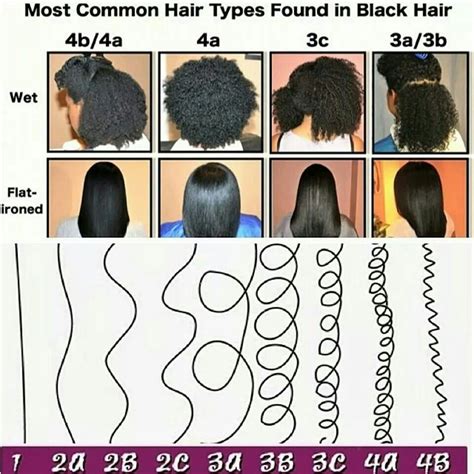Craving for Beautiful and Healthy Curls

If you’re blessed with the natural beauty of curly hair as a black person, you’ll know that it requires a unique set of care and styling techniques. Embracing your curls can be an empowering journey, allowing you to express your individuality and showcase the vibrant texture of your hair.
To guide you on this journey, we’ve curated a comprehensive guide to curly hairstyle types for black people, delving into the various textures, styles, and care tips to help you achieve healthy, luscious curls.
Understanding Curly Hair Types
The Andre Walker Hair Typing System, widely recognized by stylists and organizations like the American National Hairstyles Association, categorizes curly hair into four main types, further subdivided into subcategories based on curl patterns:
Type 3: Curly
- 3A: Loose, bouncy curls with well-defined S-shaped patterns.
- 3B: Coarser, more tightly coiled curls with a combination of S- and Z-shaped patterns.
- 3C: Tight, corkscrew-like curls that may appear frizzy when dry.
Type 4: Coily
- 4A: Fine, springy coils that form tight, spiral patterns.
- 4B: Zigzag coils that are more fragile and prone to breakage.
- 4C: Extremely tight, cotton-like coils that are densely packed and may be difficult to style.
Embracing Your Curl Pattern
Understanding Your Texture: Identifying your curl type is crucial for choosing the right hairstyles and products. Embrace the unique beauty of your texture, whether it’s loose and bouncy or tightly coiled.
Celebrating Diversity: Black hair exhibits a wide range of textures, from delicate 3A curls to tightly coiled 4C coils. Each texture is beautiful in its own way, so don’t be afraid to experiment and find what works best for you.
Finding the Right Products: Choose products specifically designed for curly hair, such as sulfate-free shampoos, conditioners, and leave-in treatments. These products will help define and nourish your curls without stripping them of their natural oils.
Styling Curly Hair
Protective Hairstyles: Protective styles, such as braids, locs, and twists, can help minimize hair breakage and maintain length. They offer versatility and can be styled in numerous ways to complement your personal style.
Defined Curls: For voluminous and well-defined curls, use styling products like curl creams or gels to enhance the curl pattern. Air drying or diffusing with a hair dryer can help preserve the curl shape.
Natural Hairstyles: Embrace your natural curls with wash-and-go styles or twist-outs. These methods allow your hair to showcase its natural texture and movement, adding a touch of effortless beauty to your everyday look.
Maintaining Curly Hair Health
Moisturizing: Curly hair tends to be drier than other hair types, so consistent moisturizing is essential. Use products like leave-in conditioners, deep conditioners, and hair masks to replenish moisture.
Deep Conditioning: Deep conditioning treatments are vital for repairing and strengthening damaged hair. Use them weekly or bi-weekly to restore moisture and elasticity to your curls.
Avoid Heat Damage: Excessive heat from styling tools can damage curly hair. Use heat protectant sprays before using hot tools and limit heat styling to occasional use.
Common Mistakes to Avoid
Overwashing: Overwashing can strip your hair of its natural oils, leading to dryness and breakage. Wash your hair 2-3 times per week, or less if your hair is particularly dry.
Brushing When Dry: Brushing curly hair when dry can cause breakage and frizz. Instead, detangle your hair when it’s wet and use a wide-toothed comb or detangling brush.
Using Harsh Ingredients: Avoid shampoos and conditioners that contain harsh chemicals like sulfates, parabens, and silicones. These ingredients can strip your hair of its natural oils and damage its delicate structure.
FAQs
-
What’s the best way to define my curls? Use curl-defining products like creams or gels and avoid touching your hair too much while it’s drying to prevent frizz.
-
How often should I deep condition my hair? Deep condition your hair weekly or bi-weekly to repair damage and restore moisture.
-
Can I use heat styling tools on curly hair? Use heat styling tools sparingly and always apply a heat protectant spray to minimize damage.
-
How can I prevent breakage? Minimize brushing, avoid overwashing, and use products that strengthen and protect your hair against damage.
-
What’s a good protective hairstyle for curly hair? Braids, locs, and twists are all effective ways to protect curly hair from breakage and maintain length.
-
How often should I trim my curly hair? Trim your curly hair every 6-8 weeks to remove split ends and keep your curls healthy and looking their best.
-
What products should I avoid using? Avoid using products that contain harsh chemicals like sulfates, parabens, and silicones, as they can strip and damage curly hair.
-
How do I know if my hair is healthy? Healthy curly hair is defined, shiny, and free of excessive breakage or shedding.
Embracing Your Curly Journey
Embracing your curly hair is a journey of self-discovery and empowerment. By understanding your curl type, adopting proper care techniques, and embracing your natural beauty, you can cultivate healthy, gorgeous curls that reflect your unique style and personality. Remember, your curls are a work of art, so nurture them with love and celebrate their vibrant beauty!
